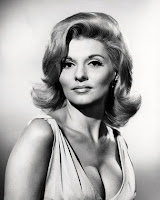 |
| Mary Steenburgen and Malcolm McDowell. |
 2. The Terminator. Given the blockbuster status of its sequels, it's easy to forget that the original Terminator was a sleeper hit by unknown director named James Cameron. Although Terminator 2 is a near-perfect action film, the first Terminator is grounded by a solid love story and gets kudos for setting the concept in motion. I imagine most of you have seen it, but those who haven't I won't spoil the "nested loop" that makes the head-scratching plot so memorable. By the way, I've often wondered if Cameron borrowed parts of his premise from the 1966 Michael Rennie B-film Cyborg 2087.
2. The Terminator. Given the blockbuster status of its sequels, it's easy to forget that the original Terminator was a sleeper hit by unknown director named James Cameron. Although Terminator 2 is a near-perfect action film, the first Terminator is grounded by a solid love story and gets kudos for setting the concept in motion. I imagine most of you have seen it, but those who haven't I won't spoil the "nested loop" that makes the head-scratching plot so memorable. By the way, I've often wondered if Cameron borrowed parts of his premise from the 1966 Michael Rennie B-film Cyborg 2087.3. Repeat Performance. Decidedly offbeat 1948 B-film stars Joan Leslie as a popular stage actress who kills her husband on December 31st--and then gets the chance to live the year over again. Knowing the outcome, can she change the events that lead up to her murderous act? This atmospheric film benefits from a surprisingly good cast with Richard Basehart, Tom Conway, and Natalie Schaefer. It was remade for TV in the late 1990s as Turn Back the Clock with Connie Selleca. Repeat Performance is not shown often on TV; I haven't seen it in years.
 4. The Time Machine. George Pal's 1960 adaptation of the famous H.G. Wells novel is still the best version. The once state-of-the-art special effects hold up pretty well and Rod Taylor makes an appealing hero (Alan Young, from TV's Mister Ed, is even better as a friend). Taylor's romance with Yvette Mimieux (as Weena of the Eloi race) lack a certain magic for me, but Wells' ideas remain fresh and the time machine itself looks way cool.
4. The Time Machine. George Pal's 1960 adaptation of the famous H.G. Wells novel is still the best version. The once state-of-the-art special effects hold up pretty well and Rod Taylor makes an appealing hero (Alan Young, from TV's Mister Ed, is even better as a friend). Taylor's romance with Yvette Mimieux (as Weena of the Eloi race) lack a certain magic for me, but Wells' ideas remain fresh and the time machine itself looks way cool.5. Somewhere in Time. There are people that loathe this film and those that love it. I naturally fall into the latter group. I must admit, though, that my perceptions are clouded...I first saw this romance with my future wife when we were young and very much smitten with one another (we still are). The plot, which Richard Matheson adapted from his cult novel Bid Time Return, stars Christopher Reeve as a playwright who falls in love with a photograph of an actress (Jane Seymour) and wills himself back in time to be with her. The leads are photogenic and likable, the location filming at the Grand Hotel on Mackinac Island is breathtaking, and the music score by John Barry (who weaves in Rachmaninoff) is one of my all-time favorites. By the way, for many years, Somewhere in Time was the top-grossing film in Japan...though it flopped in the U.S. until rediscovered years later on video.
6. Star Trek IV: The Voyage Home. Leonard Nimoy devised the entertaing premise which sent the original Enterprise crew back in time to rescue some humpback whales (who are needed to save Earth in the future). Nicolas Meyer, who already explored time travel in the aforementioned Time After Time, contributed to the screenplay. Although some of the social humor is now dated, this is one of the best of the Star Trek film series and, accounting for inflation, is probably the biggest box office hit of the original Trek pictures.
7. Back to the Future. Speaking of blockbusters, this family smash about a teenager who goes back in time and meets his parents in high school is undoubtedly the best known time travel movie with contemporary audiences. The performances are engaging and the story gets a lot of laughs out of its unlikely situations (Mom, as a teenager, is attracted to her son). The sequels, which were shot back to back, are not as good. Back to the Future 2 gets mired in its plot entanglements by sending its heroes to multiple time periods. Back to the Future 3 is set primarily in the Old West and at least restores some charm to the series.
 |
| Sean Connery in Time Bandits. |
Honorable mentions: Berekley Square and its remake I'll Never Forget You, the influential French short film La jetee, Planet of the Apes, and 1964's The Time Travelers (which may feature the most bizarre ending of all time travel movies).
OK, so there are my choices. What have I left out and how would you rank the best time travel pics?























































